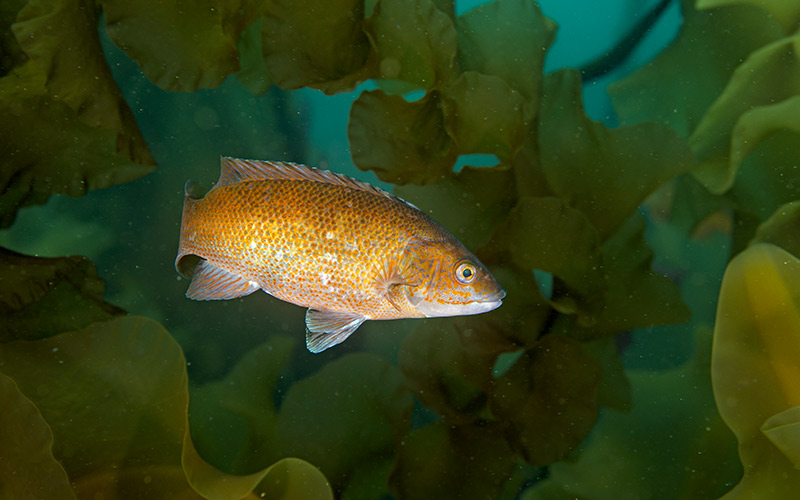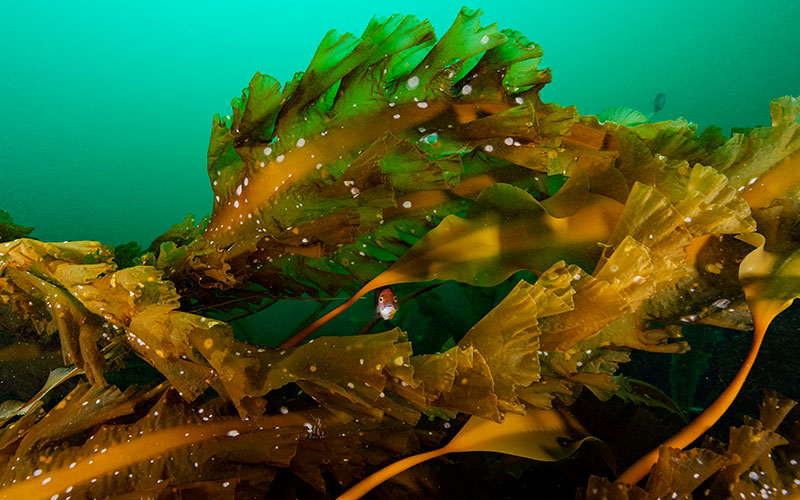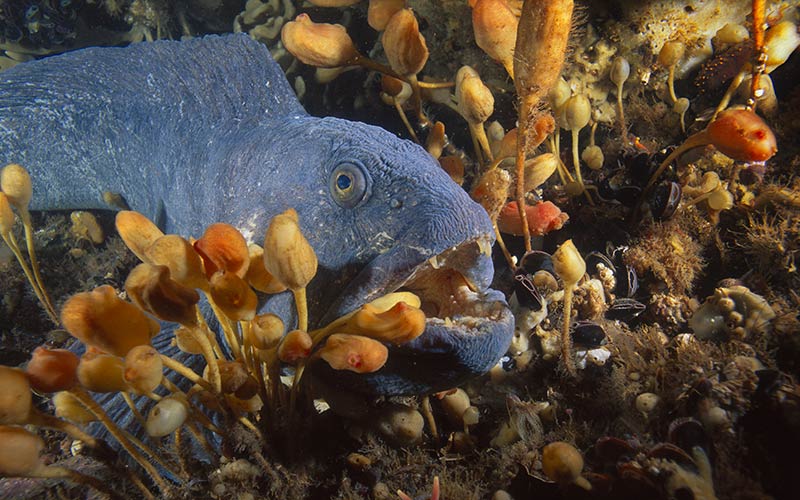
An orange cunner fish swims amid kelp on Cashes Ledge. Photo: Brian Skerry
Cashes Ledge is “like a time machine harking back to New England in the 1600s.”
– Jon Witman, Brown University ecologist
When I first read the above quote from Brown University ecologist Jon Witman, it stopped me in my tracks. As a conservationist, spearfishing guide, lobster diver, photographer, and videographer, I’ve always wished to see and experience the Gulf of Maine ecosystem before humans made a mark. So, with that, my goal was set – freedive Cashes Ledge, an underwater mountain range teeming with life 100 miles off the coast of Maine.
Freediving, simply defined, is diving without an oxygen tank by holding your breath. It is limiting in some ways, liberating in other ways. I chose to freedive the Cashes Ledge area partly for the challenge and to connect directly with the environment. Tanks and hoses would not encumber me. I would not announce my presence to nearby animals with every exhale.
So after years of wishing, eight months of planning, and two days at sea, this year I became one of, or perhaps the first, person to experience Cashes Ledge as a freediver. What I saw blew me away. I’ve become intimately familiar with New England marine ecosystems over the past 10 years, but Cashes was in a league of its own.
Codfish patrolled the kelpy, rocky bottom in numbers I’ve not seen anywhere else. Bright orange cunner, small fish also known as bergall or choggies, swarmed me like mosquitos. Schools of large pollock patrolled the mid-depths. Lobsters kept a wary eye on me from rocky crevices while I remained on the lookout for the larger species, including bluefin tuna, minke whales, and gray seals, known to frequent the area. At one point, a curious shark nosed right into the dome port of my camera.
To dive Cashes Ledge is to dive one of the healthiest kelp forest ecosystems in the Northwest Atlantic. I saw sugar kelp and horsetail kelp fronds over 10 feet long and one foot wide. The kelp was a center of gravity for the ecosystem, providing habitat, shelter, and forage for all types of life.

My diving experience focused on the kelp ecosystem, but the diverse plant and animal species that call the Cashes Ledge area home extends well beyond the limits of what I could see as a diver. Go just a bit deeper – say, from 100 feet all the way down to Cashes Basin (around 650 feet) – and you’re certain to find thriving populations of cod, lobster, wolffish, and other native Gulf of Maine species living across more than 500 square miles of seafloor, with all the ridges and ravines you might expect from an underwater mountain range.

There is so much to appreciate in our waters, but it’s hard to appreciate or protect what you don’t know. From the surface, Cashes Ledge is invisible – just an expansive blue horizon in every direction. Beneath the surface is an area so special you must see it to believe it.
But you don’t need to see Cashes Ledge to help protect it. And preservation has never been more urgent. The Gulf of Maine is warming faster than 97% of the ocean’s waters, and the protections for Cashes Ledge today are limited and not permanent.
I want Cashes Ledge to be a time machine for future generations in the same way it is a time machine today. Freediving 100 miles offshore might not be for everyone, but whether you are a diver or fisherman, boater or beachgoer, or simply someone who appreciates the natural world in New England, Cashes Ledge benefits all of us by continuing to exist as a reservoir of biodiversity within the Gulf of Maine.
Join me, join CLF. Fight to protect our waters.



